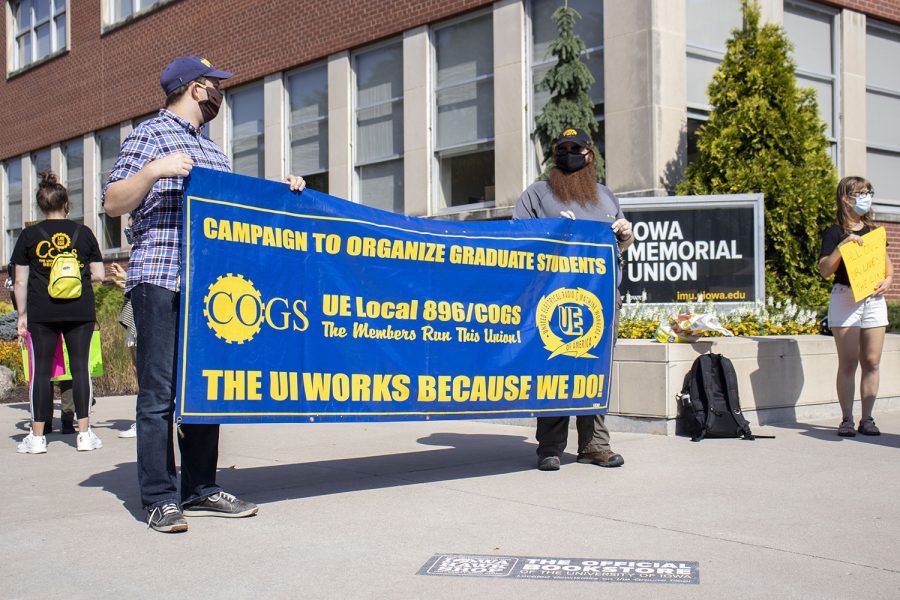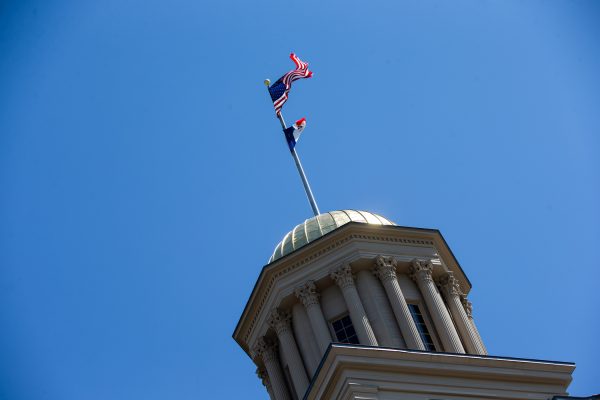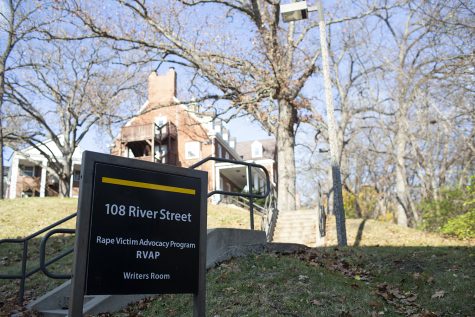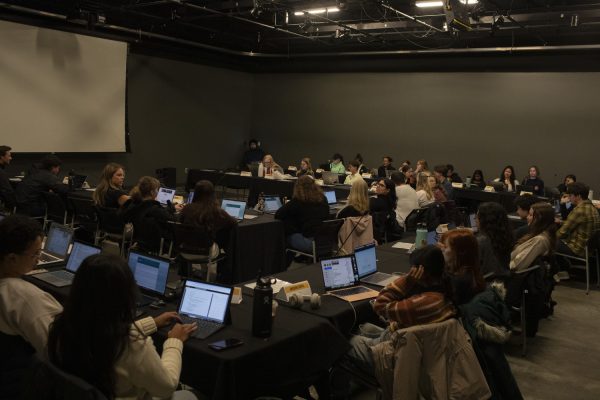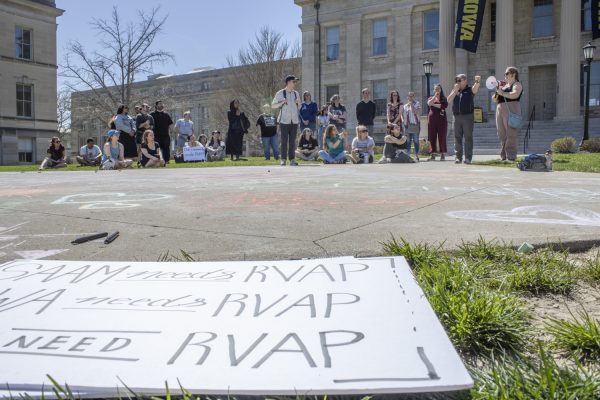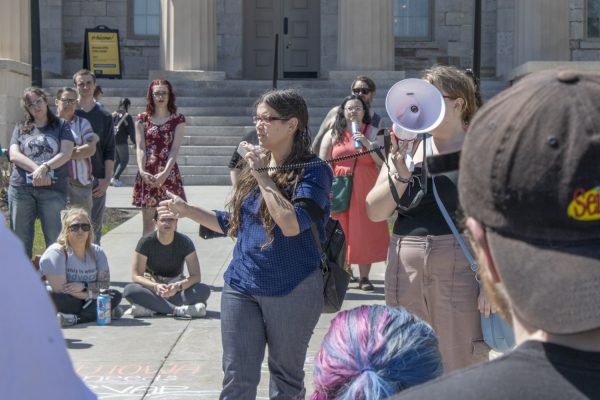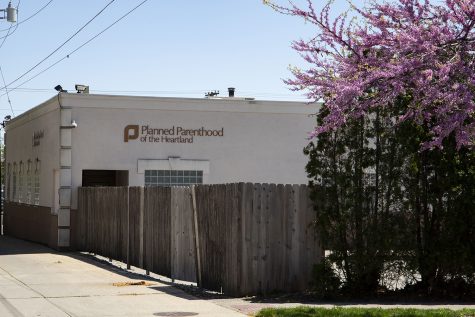University of Iowa to push forward with in-person instruction amid student, instructor calls for virtual learning
While UI administrators held a press conference in the IMU, a COGS protest went on outside the building, demanding that all classes go virtual.
A protester holds a sign outside the IMU to object against the university’s plan to offer in-person classes amid a pandemic on Monday, Aug. 10, 2020. Inside the IMU, UI administrators hold a press conference discussing plans for the upcoming semester.
August 11, 2020
University of Iowa administrators answered questions in a press conference on Monday on a long list of policies that administrators say will allow students, faculty, and staff to return to campus safely for in-person learning. Just half an hour beforehand, a protest by a graduate student union advocated for administrators to forego its plan for in-person instruction, saying preparations are not enough to keep students, faculty, and staff safe from the coronavirus.
Four UI administrators at the conference reiterated that the campus policies allowed “room for choice” for faculty, staff and students on whether to learn in-person.
“Implementing these policies has created room for choice. Choice for our students, families, and our instructors,” said Kevin Kregel, the UI interim provost and executive vice president.
More than half of undergraduate hours in either an online or blended format, Kregel said, which means instruction would take place partially online, with discussion sections and labs in person. Over 900 instructors had signed up for virtual learning workshops. Face masks will be required on campus, and UI employees that work outside of health care are being asked to complete an online training session addressing policies and expectations surrounding COVID-19.
Kregel said instructors can fill out a form requesting a temporary alternative work arrangement, which would move their course online. Approval would be based on the situation such as having a preexisting condition or a high-risk family member. He said that the university is still formalizing criteria that would qualify instructors to move to online-only instruction. The university has approved 200 Temporary Alternative Work Arrangement (TAWA) requests on the academic side of the university, said UI spokesperson Jeneane Beck, which includes all types of university employees.
Administrators are also “in the process of finalizing” metrics and thresholds to guide university decisions, such as reverting to all-online classes Kregel said. Beck said the university didn’t have a set timeline to develop those metrics, but said that it would be done before classes began Aug. 24.
The university has received pushback from student leaders to its in-person plan. Student governments urged the administration to move to online instruction and 280 instructors signed a pledge committing to a digital return to campus. A public petition calling for the university to move to online learning has collected more than 700 petitions as of Tuesday.
RELATED: Student governments urge University of Iowa to move to virtual learning
About 30 minutes before the press conference was set to begin, with face masks and signs, roughly 40 protesters, many of them graduate students, gathered outside of the Iowa Memorial Union. They came out on Aug. 10 in 80+ degree heat to show their opposition to the university’s hybrid learning plan and advocate for completely online learning.
The protest was organized by Campaign to Organize Graduate Students. Another protest is scheduled for Aug. 19 at 4 p.m.
Caleb Klipowicz, an Anthropology graduate student who attended the protest, heard about the event through social media posts from COGS. Klipowicz will be a TA in the fall for “Contemporary World Problems,” and he found the UI’s response to COVID-19 “totally unacceptable.” He joined his fellow grad students to demand classes move online.
“In-person classes are simply too dangerous for everybody, for students, for TAs, for RAs, for professors. Nobody’s on board with this. Undergrads have signed against it, graduate students have signed against it, faculty have signed against it,” Klipowicz said. “The only people who want this are the administration and it’s simply not worth risking a life or losing a student to hold a class.”
Jessie Kraemer showed up to the protest with a sign that had “I wouldn’t actually die to go to the University of Iowa” written in red paint. Kraemer, a graduate student in the nonfiction writing program, doesn’t think in person learning will be safe or convenient. She says it’s not responsible to hold in person classes when UI has the resources to teach online.
“I teach gen ed lit, and we’re going to be talking Shakespeare and Toni Morrison and all these things are extremely important, right? I love books, but no one should die to learn how to scan a poem,” she said.
The protest began 30 minutes before the university’s press conference. Organizers said the timing of the protest was intentional. John Jepsen, a graduate student in the history department, said graduate students wanted to share their side as administrators shared theirs.
“My hope is that in there being a sort of like a solid message across the board coming from various departments, faculty, graduate students, undergraduates, professional students, all of them saying that the idea of forcing people to have to teach in small classrooms, is just a bad idea, especially when the pandemic isn’t under control in our geographical region,” Jepsen said.
Fifteen minutes before the press conference began, Jepsen spoke to the protestors on a megaphone.
“We are here to remind … the administration that we are watching them and we told them how we feel, we told them what we believe, and we’re not going to shut up, we’re not going to be silent,” he told them.
During the press conference, Rod Lehnertz, senior vice president for finance and operations said it’s important to “keep in mind” that there are more than 30,000 students and thousands of faculty and staff on campus with a wide range of opinions on returning to campus.
“And all of them matter to us and help as the critical incident management team event and college leaders and university staff continue to ready this campus, our goal is to make sure that we provide as much choice and as much certainty as we’re able in this environment while aligning to the Board of Regents, state of Iowa objectives and also as I mentioned earlier now part of public health and CDC,” Lehnertz said.
Kevin Kregel, interim provost and executive vice president, spoke on the university’s plan not to test students when they arrive on campus, saying it would give students a false sense of security and it would require significant resources and training to administer. He also said the university would only use FDA approved tests and students will have testing available to them through the Student Health Service.
Instead, Kregel said, the university is taking CDC-recommended infection prevention steps, such as reducing campus density, modifying classrooms and requiring face coverings. Contact tracing will be completed by the Johnson County Public Health department, which has 27 trained individuals in contact tracing as of Monday. It’s working to expand its capacity, said Community Health Manager Sam Jarvis.
Sarah Hansen, vice president for student life, said a limited number of people would be allowed during move in to promote social distancing and said OnIowa! has been upgraded to include virtual and social distanced activities, such as virtual bingo.
Dan Fick, University of Iowa campus health officer said in preparation for the fall semester, the UI has installed cameras and audio visual equipment in every classroom and taught exercises to accommodate for social distancing in the classroom.
“We’ve provided assistance for instructors and our teaching assistants for converting their courses to an online format. We had a remote institution team and they provided arrangement assistance to our instructors, including individual consulting sessions,” Fick said.
He also said the university is going to continue to work with students that need access to technology so they can participate in online classes.
When asked by a reporter about the pushback university administrators had received about returning to hybrid learning from faculty, graduate and undergraduate students, Lehnertz said the university has continued to work with shared governance leaders.
“Throughout the process of our getting ready for this fall semester we have continued to work with our shared governance, leadership and faculty, staff leaders, as well as undergraduate and graduate professional student leaders,” Lehnertz said.
When the press conference was over, protesters were still standing on the corner. As administrators walked away from the IMU, they chanted “classes online.”
After several students from different areas of study spoke, Micheal Goldberg, a graduate student in the department of education, said the concern for safety was broad.
“This affects all of us. It affects every single person in Iowa City, whether or not they are a part of this university. The university is one of the largest employers in the state, the university has the power to to take action, to get in front of this virus and they are refusing to do so,” Goldberg said.




